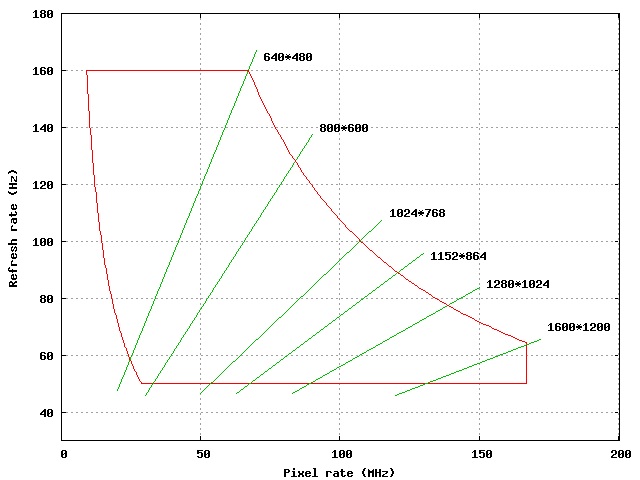
In 1995 I intended to buy a personal computer. Of course, I wanted to get the best components I could afford, but I had difficulties understanding the capabilities of graphics cards and monitors (at that time CRTs, i.e., cathode ray tubes). In particular the relationship between the graphic chip's properties, the screen's resolution, and the resulting refresh rate seemed to me to be far from obvious. As the refresh rate is the most important ergonomic property of a CRT monitor and as I intended to spend quite a lot of time in front of the screen, this worried me.
However, after reading
Eric S. Raymond's very informative
document The Hitchhiker's Guide to X386/XFree86
Video Timing
I realized that one could obtain a simple graphical
description of a monitor's capabilities.
The key idea for this solution was
that one had to make a few assumptions which, although not strictly correct,
were nevertheless accurate enough.
The result can be seen in the following example diagram (which, incidentally, shows the properties of the monitor I finally bought):

The horizontal axis is the graphics chip's clock rate (input to the monitor),
the vertical axis shows the monitor's refresh rate (result).
Monitor states with the same screen resolution lie on straight lines through
the origin of the diagram.
The interesting point is that a monitor's basic data can be rephrased as a
capability region
on this diagram;
everything within this region is within the monitor's capabilities,
everything outside is not:
As one's goal normally is the highest possible refresh rate, the most interesting curve is obviously the upper right hyperbola. By looking at the points of intersection between this curve and the lines of resolutions you can immediately read off the maximal supported refresh rate for a resolution and the clock rate needed to achieve it.
I sent a description of these ideas to Eric S. Raymond who incorporated them in version 2.4 of his guide.